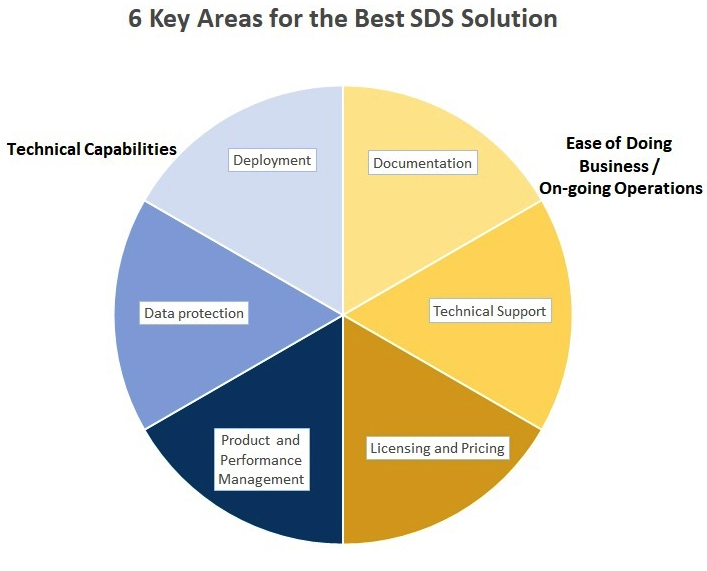6 Key Areas for Selecting Best SDS Solution
Deployment, data protection, product and performance management, documentation, technical support, licensing and pricing
This is a Press Release edited by StorageNewsletter.com on October 29, 2020 at 2:17 pm![]() Published on October 22, 2020, this article was written by Todd Dorsey, analyst, DCIG LLC.
Published on October 22, 2020, this article was written by Todd Dorsey, analyst, DCIG LLC.
6 Key Areas for Selecting the Best Software-Defined Storage Solution
More organizations than ever plan to adopt public, private, and/or hybrid clouds. As they do, they must select and acquire solutions that align with these cloud types’ technical requirements. Selecting the most appropriate SDS solution for these clouds represents a key decision all organizations must make. Among them, enterprises must carefully consider multiple SDS features to make the best decision.
To help these organizations, DCIG plans to publish one or more reports focused on SDS block storage. In preparing these reports, it identified and researched 6 topical areas that organizations typically evaluate when selecting an SDS solution.

Six Topical Areas for Evaluating and Selecting Best SDS Solution
1. Deployment
Unlike hardware storage solutions, organizations must examine the storage software more carefully as it will run in their environment. This means they must examine how they will deploy it in their environment. Features examined around each solution included:
• On-premise, hybrid, and public cloud deployment capabilities
• Integration with available hypervisors
• Availability as a virtual application
• Certifications with equipment, operating systems, and applications
• Level of support for existing storage protocol standards
• Capacity capabilities
• Multi-tenancy support
2. Data Protection
Data protection as it relates to SDS solutions encompasses their availability, encryption, replication, and snapshot features. These features protect organizational data from either intentional or unintentional loss. In this vein, DCIG evaluated each solution’s respective ability to deliver on these four attributes.
3. Product and Performance Management
Organizations will find SDS solutions give them many more options to manage the underlying hardware and optimize it for performance. In these areas, DCIG evaluated the following SDS capabilities:
• Product dashboard views
• Predictive analytic
• Storage optimization techniques such as compression and deduplication
• QoS features that enable and prioritize performance
• Auto-tiering capabilities
• Tuning for IO/s and latency needs
• Directory service integration and support
4. Documentation
The SDS solutions that DCIG evaluated ranged significantly in their levels of maturity. This product maturity shows up in ways other than simply how easy it is to deploy, manage, and optimize the solution. It also shows up in the breadth and depth of documentation that provider makes available.
In this area, DCIG evaluated the following:
• The number and applicability of whitepapers that address specific application or system architectural questions
• The availability of an online knowledge base
• An active community forum for asking and searching questions and answers
• Searchable, online user or administration manuals
5. Technical Support
Like documentation, the levels and types of technical support available from SDS solutions vary. DCIG always looks at this area and puts a lot of weight on each provider’s ability to deliver top notch technical support. While product features certainly matter, technical support often takes a close second. Key technical support features that DCIG evaluates include:
• Hours of availability
• Response time commitments to new cases
• Ways to report and open new incidents
• Escalation support
• Proactive issue resolution
6. Licensing and Pricing
Licensing and pricing always garner attention. However, organizations should also consider these attributes in light of the underlying quality of the solution. Like most technologies, you tend to get what you pay for. While DCIG does not formally evaluate product pricing in its final assessment, it does evaluate the following:
• Bundled features or a la carte
• Contract lengths
• Pricing elements
Top 5 SDS Solutions Best Deliver on These 6 Categories of Features
DCIG uses features within these 6 categories to evaluate and research SDS solutions to arrive at its Top 5 recommendations. The first 3 areas focus more on the solution’s technical features while the last 3 come into play around ease-of-doing-business and ongoing operations.














 Subscribe to our free daily newsletter
Subscribe to our free daily newsletter

